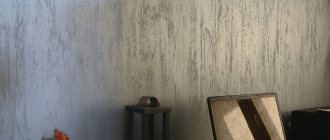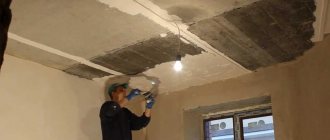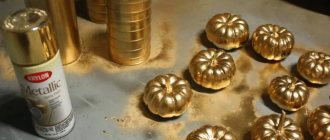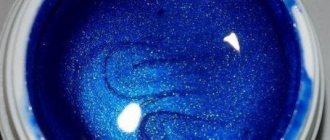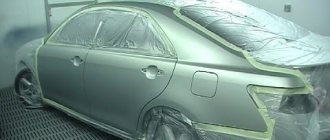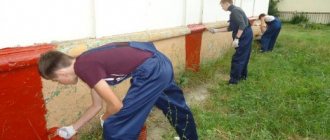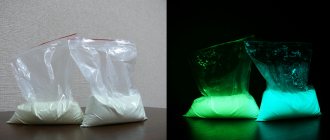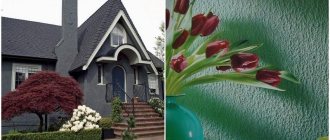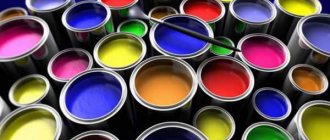Playing with color
Chrome paint has several types, each of which provides a high-quality chrome plating effect due to the high reflectivity of the metal powder it contains. The most common type of paint is mineral chrome paint, which contains aluminum powder. These dyes are produced either in cans for use with a spray gun, or in the form of an aerosol. The second option is best suited for DIY dyeing. There is also powder paint, which is especially durable and heat-resistant.
In addition to the smallest metal particles acting as a filler, the product contains an alkyd or nitrocellulose varnish base, which reliably binds them when applied both to each other and to the surface. The most important property - specular reflectivity - is ensured not only by the use of powder, but also by the original properties of the varnish, which allow the composition to be evenly distributed. In addition to the fact that chrome plating looks much more impressive than matte, it has the property of heat-resistant protection and considerable strength.
Depending on the added dyes, several types of coatings are distinguished:
- The most common chrome finish is the classic variation, which has a white mirror finish similar to polished silver. In this case of chrome plating, no additional dyes are added.
- It is not uncommon to see gold chrome. The noble shade is achieved through the use of yellow metal particles in the paint. When completely dry, this mixture forms a mirror-like gold metallic.
- In addition to the two main options, there is the possibility of experimenting with color. Painting under chrome in other tones is carried out by introducing a certain volume of pigment of the required shade into the varnish.
- Black chrome has an original effect that deserves special attention. This paint contains, in addition to aluminum powder, a dark translucent pigment.
All of the listed types have a glossy mirror surface when dry, reminiscent of liquid silver. There is a very different variety - matte chrome. This is a fairly popular type of painting, often used for interior parts. A beautiful matte effect is obtained by slightly changing the composition of the paint, giving the reflectivity some dispersion.
Coating options
There are several types of coatings, depending on the ingredients used:
- The classic version of painting chrome on metal is the most common. These are compositions with a white mirror shine. They are similar in appearance to polishing silver. Additional dyes are not used in this case. The chrome effect is ensured without them.
- The gold version of chrome plating is also quite common on the market. The paint contains yellow metal particles, which makes it possible to obtain a noble shade. The mirror gold metallic effect appears when the composition dries completely.
- Black chrome has a very original effect created by the surface itself. There are special spray paints designed not only for car wheels, but also for plastic and various products made from it. The photo below shows the decorative effect itself.
It is possible to conduct additional experiments with colors. Heat-resistant spray paint is no exception. You just need to introduce a certain amount of pigments into chrome that have one color or another.
Any chrome paint forms a mirror-like glossy surface when it dries. It looks like liquid silver. Matte chrome is the option that differs most from previous varieties. This popular spray painting solution is used to decorate the interior.
It is necessary to slightly change the composition of the paint to achieve an unusual effect on the surface. Otherwise, painting under chrome will not achieve the desired result.
In the video: spray paint with bosny chrome effect.
Chrome chameleon
In addition to the usual metallized chrome paints, which give the effect of a mirror shine and matte finish, compositions with other interesting properties have been developed. These products include thermochromic paint. Its main feature is that it changes its color when the temperature acting on it changes, while at the same time being quite heat-resistant. The colors and shades are very diverse, a matte effect is possible, the coating can even become transparent.
Thermochromic paint is classified by two methods: by the type of color change and by the reversibility of this change. In the first case, three varieties are distinguished:
- The coating, being initially transparent, acquires a certain tone when it deviates from room temperature towards heating or cooling.
- The opposite option: the paint, which is colored, becomes transparent under different temperature fluctuations.
- As the ambient temperature changes, the color of the composition tends to gradually change from one to another.
According to the second criterion, thermochromic paint is divided into reversible and irreversible. As is easy to understand from the name, reversible changes color as many times as desired, and irreversible - only once.
The originality of this composition, however, has not found wide application. The reason was the considerable cost and labor-intensive method of dyeing. Chameleon effect paint is mainly used to make souvenirs, for example, mugs with interesting matte and glossy designs that can only be seen when you pour a hot drink inside. On the packaging of some food products there are special marks made with thermochromic paint, allowing control over the temperature conditions of storage.
Chrome effect paints
Paintwork materials that create the effect of chrome or nickel plating are produced in cans and aerosol cans. According to experts, canned compounds are more difficult to apply, but the paint film is more similar to a natural metal coating. You can achieve perfect aesthetic similarity. It is better to paint a disc or headlight contour that you are restoring yourself using canned paint. Aerosol cans are purchased by beginners, who find it difficult to apply professional formulations in an even layer.
Aerosol cans are purchased by beginners, who find it difficult to apply professional formulations in an even layer.
Composition and characteristics
In terms of their component content, paints and varnishes differ due to the base. A binding film-forming base is added to the metal crushed to a powder state. Alkyd, acrylic, resin or nitrocellulose compounds help distribute the powder evenly. After drying, the base becomes transparent, metal particles are clearly visible, it is the powders that create a mirror-like, reflective surface.
Manufacturers offer a wide range of coatings with a metallic sheen for metal, plastic, and wood. Chrome paint comes in:
- Single-component, these are aerosol packages, nitro paint of the middle price category;
- Two-component based on acrylic or epoxy resin, it is characterized by increased resistance to moisture, dirt, and is not afraid of the effects of detergents (car shampoos, non-aggressive household chemicals).
To improve the visual effect, varnish is additionally used; it strengthens the film layer. Under the chrome paint the wood looks like metal. Heat-resistant powder coatings are diluted in a special way; they are more complex in structure. They form coatings closer to natural chrome plating - stable, bright.
To improve the visual effect, varnish is additionally used; it strengthens the film layer.
Dyes are available in different colors:
- Silver, simulating nickel, chrome;
- Gold ones with powder from colored alloys achieve a noble yellow tint;
- Dark - black, blue, other shades.
All paints for chrome plating are shiny, with good reflectivity, and form a protective film in the form of a mirror.
All paints for chrome plating are shiny, with good reflectivity, and form a protective film in the form of a mirror.
Advantages and disadvantages of spray cans
The main advantage of chrome paint in cans is that it can be applied without using a brush, your hands will remain clean. The main disadvantage is that the cylinder holds a small amount of paint and varnish.
Aerosols are used to hide minor defects on metal; powder paints perfectly mask rust.
Other advantages of chrome spray paint:
- The aerosol is ready for use; to paint, just remove the cap from the can and press the sprayer;
- Versatile, the mixtures are designed for coloring various materials, including plastic;
- No tools or equipment are required for work;
- An aerosol can is a sealed container, the paint is well preserved in the packaging and does not lose its original properties;
- Manufacturers offer a varied palette of colors, you can easily choose the desired shade;
- With aerosol spraying, the layer dries quickly;
- No special preparation is required for coating application.
Now about the disadvantages:
- It is difficult to process large areas;
- There may be problems with painting some types of polymers; with glossy plastics, the layer is scratched.
An aerosol can is a sealed container; the paint is well preserved in the packaging and does not lose its original properties.
Dyeing technology
It’s worth dwelling on how to paint car body parts with chrome paint yourself. First of all, surface preparation is important, especially if it is glossy rather than matte. After all, on a detail as smooth as a mirror, even the most microscopic defects will become very noticeable. It is imperative to ensure that there is no dust in the room, otherwise all efforts will be in vain.
After checking these conditions, you can proceed directly to painting.
The liquid acrylic composition has its advantages - it is heat-resistant, withstands chemical influences, humidity, and unlike the powder version, it can be applied only to part of the part, making it multi-colored.
The process itself is as follows:
- Cover the primed surface of the part with a layer of black dye.
- When it dries, polish it.
- Apply the required number of layers of chrome paint with an aerosol, drying each of them in between.
- Finally, varnish the part.
Powder paint has a slightly different composition, due to which it has increased strength indicators: it is resistant to solvents, less susceptible to rust, heat-resistant and durable.
Alloy car wheels are painted using powder technology. Modern developments make it possible to perform this process with your own hands in a garage, since they do not require high exposure temperatures. The whole procedure consists of four stages:
- thorough cleaning of parts;
- primer coating;
- drying;
- applying powder paint.
In addition to alloy wheels, heat-resistant chrome paint in powder form can also be applied to other metal parts.
A wide selection of existing types of chrome paint and an extensive color palette allow you to create a high-quality coating for every taste. You can apply both the powder version and the aerosol yourself, creating a glossy or matte effect. With the right skills, it will not be difficult to bring any idea to life.
Cost of coloring
| Type of work | Price |
| Cleaning the surface from corrosion | from 142 RUR/m² |
| Surface primer | from 120 rub./m² |
| Degreasing | For free |
| Surface painting | from 120 rub./m² |
| Anti-corrosion painting of metal structures | from 180 rub./m² |
Request for painting
The cost of powder painting is calculated based on the price of painting a meter and is determined by several factors:
- volume of work (size and shape of parts);
- the amount of powder material consumed;
- the type of paint used;
- additional work (loading, unloading, packaging, etc.).
Buy powder mirror paint chrome
You can buy powder paint at a competitive price from us or from an official dealer of the company.
- own production with unique developments;
- wide range of chrome powder paint;
- the ability to place an individual order for an agreed batch of supplies;
- maintenance at all stages;
- affordable prices.
You can purchase chrome paints from our production from distributors or directly from the company. You can fill out an application either on the website or by calling our call center operators.
You may also be interested in matte powder coatings or glossy powder coatings.
Request a call back
We will call you back shortly
Spraying metals and their oxides onto glass makes it possible to improve the quality of glass, as well as give it some additional useful properties. Surely many of us have noticed “one-way” mirrors in films. With their help, those outside the room can observe those inside. The latter, in turn, do not see those who are outside, and can only see their own reflection in such glass. Such glasses exist in reality and are most often used not for espionage, but to protect various objects from prying eyes, and mirror coating is used for their manufacture.
Sputtering technology
The principle of this effect is based on the fact that a darkened room is very difficult to see against the backdrop of a brighter reflection. To date, there are no translucent mirrors that would be able to transmit light in one direction and not in the other.
In order to make such glass, people began to use special methods that allow them to create products with a one-sided effect. Thus, ordinary mirrors are glass with a very dense and thick reflective coating applied to the back surface. Mirrors with one-sided transparency are made in a similar way, but a thinner coating layer that transmits light is used.
As an alternative, today a mirror film is often used, which is applied to the surface of the product. Such a mirror film can be easily applied to a finished product.
There are two main spraying methods:
- pyrolytic method (carried out at the manufacturing stage);
- vacuum-type spraying (applied to finished products using a special type of installation).
Today there are several types of vacuum deposition, the most popular of which are:
- magnetron high-speed;
- ion-plasma.
Magnetron sputtering
This type of processing involves applying various types of metals and their compounds to the surface of glass using the magnetron sputtering method. Products are processed in a closed space. This processing is carried out at the molecular level, due to which the products receive high quality and performance characteristics.
To achieve the desired effect, gases of various types are often used - oxygen, nitrogen or argon. During the reaction, layers of metals are formed on the surface of the product. This makes it possible to produce glass with various specified characteristics.
Glass tinted using magnetron sputtering technology has a number of advantages:
- excellent reflective characteristics;
- excellent heat reflection characteristics;
- thanks to the ability to simulate the thickness of the layer of applied metal, manufacturers can produce glass with the necessary characteristics of light reflection and light transmission;
- This type of coating can even be used for processing patterned glass.
- relatively low and affordable cost.
Ion plasma sputtering
To apply ion plasma sputtering, it is necessary to place the product under vacuum conditions. In a closed space there is an inert gas, cathodes with a negative charge and a metal coating, a positively charged anode, and a bearing with a triple liner.
During processing, the spray layer is applied specifically to the bearing. The plasma method makes it possible to apply alloys of a wide variety of metals, as well as their compounds, such as titanium, silver, aluminum, nickel, chromium, etc., onto the surface of products.
The quality of the coatings applied will always directly depend on the quality of the surface. In this case, even such points as the roughness or texture of the workpiece, the quality of preparation of the surface itself, and production culture are taken into account. It can be noted that the limiting factor that influences the spread of this method is the fairly stringent requirements for surface preparation, as well as the cost of the equipment used.
Sapphire-coated glass deserves special attention. In the watch industry, this technology is often used to create watch faces. The material used for production is mineral glass, which, in turn, is artificially grown from silicon oxide crystals.
For lovers of especially durable glass, craftsmen from Switzerland have learned to create glass even from artificial sapphires. Such products are characterized by high strength and no less high cost. The solution between strength and cost was found after the invention of mineral glass, which was coated with sapphire. This type of spraying has the strength of sapphire and the cost of ordinary mineral. The only drawback is the rapid abrasion period.
Technologies make it possible to apply high-quality tinting, low-emissivity, self-cleaning coatings to the glass surface, which can be effective to any given degree.
Coatings containing oxides are more durable than metal coatings. They are more resistant to external influences and are chemically related to glass.
How to make a mirror surface on glass at home
The ability to create mirrors with your own hands is a fascinating activity. Even though furniture stores are full of mirrors of every shape and size, creating something with your own hands brings special pleasure. From a practical point of view, this is even a useful activity. Because it can be useful in repairing optics and lighting devices containing mirror elements. However, this will require a separate room with the functions of a chemical laboratory.
Necessary materials
To work you will need the following elements:
- Goggles, rubber gloves, respirator;
- Vessels or containers for working with solutions, glass rod;
- Silver nitrate;
- Caustic potassium;
- Ammonia;
- Spray;
- The piece of glass is high quality, beautifully shaped, smooth;
- formalin in solution;
- Paint of any color;
- Chalk;
- Cuvette;
- Distilled water.
Useful: You can obtain silver nitrate yourself from an old silver coin by dissolving it in a 10% silver solution. Be sure to follow protective precautions when doing this.
Procedure
To create a mirror, the technique of chemical silvering of glass is used. First, you should properly prepare the glass surface of the future mirror, always holding it only by the edges so as not to leave stains on the smooth surface. For this:
- it is washed well on both sides, as well as the ends, with distilled water and crushed chalk;
- the entire area of the glass is degreased by wiping it with a napkin containing an alkali solution of 10 - 15% consistency;
- wash again with distilled water;
- dried;
- immersed in heated distilled water (the glass blank should be 10 degrees hotter than the silvering solution).
Next, a silvering solution is prepared. This is a two-step process:
- Stage one. Distilled water is mixed with silver nitrate in a proportion of 30 ml per 1.6 g. 25% ammonia is dripped into the resulting composition until the sediment disappears. As soon as there is no precipitate, add 100 ml of distilled water.
- Stage two, final. The resulting solution and 5 ml of formalin solution of 40% consistency are mixed. The solution for silvering is ready.
The glass is removed from the warm aqueous environment and placed on a special flask or cuvette. The silvering solution is poured into the middle and rolled out in an even layer using a glass rod. You can lower the glass blank directly into the solution, but so that the opposite side is not flooded with it. The chemical reaction takes three to ten minutes. After finishing, the resulting mirror surface should be washed with distilled water.
Next, the process of making the mirror continues with two hours of drying of the silver-plated surface. In this case, the temperature is maintained at a level of 100 to 150 degrees. The glass must be vertical. After the specified time has passed, the cooled surface is coated with transparent varnish using a spray bottle. If you get silver streaks, you should wipe them off with a cloth with a weak solution of nitric acid before applying the varnish. The silvering process is completed by horizontal drying of the mirror.
If the inner surface of the glass is endowed with the properties of a mirror, opaque paint of any color is applied on top of the silver layer. In order for the outer surface to serve as a mirror, the glass blank is kept completely lowered into a special container with a silver composition for 5-10 minutes.
Important: When working with chemicals, be sure to use goggles, a respirator and rubber gloves. It is forbidden to breathe the fumes of the resulting solutions. If it gets into eyes, rinse with clean water and consult a doctor.
How to paint a car chrome yourself
Unfortunately, most chrome plating methods used in modern auto repair shops cannot be used at home. But chrome coating of plastic and body parts can be done in your garage if you know some painting secrets.
The room in which the procedure will be carried out must be thoroughly cleaned of dirt and accumulated dust. You will also need an airbrush, which will be needed during the process. To understand what effect you can really achieve, before starting the procedure, you can experiment a little on old car parts. The entire procedure for chrome plating a car includes several stages:
- The prepared part is coated with black paint.
- Only after it has completely dried, the surface must be thoroughly polished. Outwardly it should resemble glass.
- The surface is degreased with alcohol and then warmed up well with a hairdryer.
- Then chrome is sprayed (you must remember that there should be more air in the tool than paint). After complete drying, the surface is polished again.
You will need to apply several layers of chrome, after thoroughly drying each one. Then the part will need to be dried (the better the drying, the stronger the mirror effect will appear).
Painting wheels in chrome
Today you won’t surprise anyone with chrome wheels, although a few years ago painting wheels chrome was a great way to make your car stand out from the crowd of others. Chrome plating of disks is the application of a special coating to them, which creates a mirror effect.
Such tuning allows you not only to decorate your vehicle, but also reliably protects the wheels from various damages, environmental influences and corrosive processes.
Chrome rim painting is especially suitable for car enthusiasts who prefer to drive at high speeds, since strong pressure, load on the rims and temperature changes provoke premature wear and breakage.
How to paint wheels chrome with your own hands?
Before coating, the disc must be prepared (sanded and polished the surface), then degreased so that the adhesion of chrome and the disc is as strong as possible. All disk mounting holes must be closed to prevent chromium from getting into them.
For painting, you can purchase a special aerosol can and carry out the procedure at home. But this does not guarantee the appearance of a mirror shine on the discs, and the effect will last until the first wash.
All methods of painting wheels in chrome are not considered to be of high quality, since the desired result can only be achieved by painting with chrome itself.
Therefore, it is better to entrust this procedure to professionals who will provide high-quality diffuse or galvanic chrome coating of the disks.
Do you want to know everything about car painting? Read more useful articles:
- . We paint with our own hands.
- . Use it wisely.
- . What is necessary for painters?
Elements and details with a shiny mirror surface add elegance to the interior and tuning of the car. It is impossible to make a full chrome coating at home. Sophisticated energy-intensive equipment is available to businesses. Electroplating is done only on metal with a low carbon content. Chrome paint creates the complete illusion of an expensive coating, and with simple equipment and patience, the chrome effect can be done with your own hands on various materials, including plastic.
Mirror paints
Application area
Christmas decorations
- At the moment, two types of mirror coatings are used: powder paints and aerosol cans. The second option is available to almost everyone - it can be used both for painting parts of motorcycles and cars, and for various decorations. For example, mirror paint for plastic, metal or ceramics can become an important element in the interior of your home, as it can originally diversify the color scheme of the overall decor.
Mirror motorcycle - much cooler
- Of course, such coatings are most appropriate in mechanical engineering, as you can see by looking at the top photo - chrome-plated parts of a motorcycle or car are always attractive and very beautiful. In addition to beauty, chrome powder paint of any color provides anti-corrosion and high mechanical strength to the coating.
- The process of applying powder compositions consists of three main stages, these are a) preparatory treatment of the surface of the part; b) applying powder to the surface using a sprayer; c) polymerization or melting of the powder in an oven. And if we talk about the principle itself, then dust particles of powder are attracted to the grounded part, which then melt.
Note. Regardless of the method used to paint objects (polymerization, aerosol), in any case the surface to be treated must be cleaned. This is done in two ways - chemical and mechanical.
Painting various surfaces
Chrome effect compounds can be used to paint different types of materials. The general principles of operation for all bases are similar, but some points may differ.
Working with metal
This type of finishing is most often used for metal. The surface should be chromed as follows:
- The element is thoroughly cleaned of contaminants.
- Anti-corrosion treatment and degreasing are carried out.
- Damaged areas are puttied and sanded.
- The part is again cleaned of dust.
- A layer of primer is laid.
- After complete drying, black paint is applied, it serves as the base. It is impossible to create a mirror finish without a base layer using a simple method at home.
- The base is polished. For this, a soft abrasive is used; damage to the layer must not be allowed.
- The selected composition is prepared for work. The aerosol in the can is shaken thoroughly and for a long time; if it is a liquid composition, it is diluted and poured into the spray gun.
Attention! It is impossible to ideally apply the coating under chrome with a brush or roller; only spraying gives the desired result.
- The paint is applied in a thin layer, the number of which varies from one to three.
- If necessary, after drying, light polishing and cleaning is carried out.
- Colorless varnish is placed on top.
A better visual effect can be achieved by heat treatment of powder paint.
Plastic processing
When working with plastic, the following technology is used:
- The surface is carefully prepared and polished to ensure impeccable smoothness.
- A layer of black paint is applied and polishing is carried out again.
- The surface is heated with a construction hairdryer and treated with a chrome compound.
- After complete drying, polishing is repeated. If required, varnish is applied.
Chrome plating at home does not always give the result that is obtained in industry, but the prospects for the development of this area are broad.
